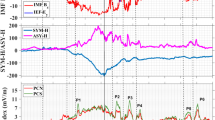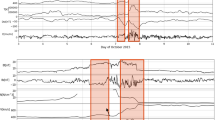Abstract
We investigate multi-scale ionospheric responses to the May 27, 2017, geomagnetic storm over the Asian sector by using multi-instrumental observations, including ground-based global navigation satellite systems (GNSS) network, constellation observing system for meteorology, ionosphere and climate radio occultation, the FengYun-3C (FY-3C) GNSS occultation sounder electron density profiles and in situ plasma density observations provided by both Swarm and defense meteorological satellite program missions. This geomagnetic storm was an intense storm with the minimum symmetric horizontal component reaching − 150 nT and was caused by a coronal mass ejection released on May 23. The main observations are summarized below: (1) two ionospheric positive storm periods were observed. The first one was observed in the noon–afternoon sector during the main phase of the storm on May 28, with nearly 120% TEC enhancement. The second one was of a smaller scale and occurred on the nightside during the recovery phase of the storm on May 29. The first dayside positive storm was initiated by the interplanetary magnetic field (IMF) Bz southward turning and eastward penetration electric field, while the second nightside one was terminated by a later southward turning of the IMF Bz since the Asian sector was on the nightside and the penetration electric field changed westward. (2) A negative storm occurred from 00:00 to 12:00 UT on May 30 over the Asian sector, nearly 2 days after the main phase, which was due to the thermospheric composition change, i.e., decrease in the O/N2 ratio, as shown in the TIMED/GUVI measurements. (3) A band-like TEC enhancement was observed aligning in the northwest–southeast direction and propagated slowly southwestward from 15:00 to 20:00 UT (23:00–04:00 LT, near midnight) on May 28 during the recovery phase of the storm. In situ density observations from the Swarm B and DMSP F15&16 satellites confirmed the density enhancement at 510 km and 850 km, respectively, and revealed that this band-like TEC enhancement structure resembles the so-called plasma blob. The similarities of the observed plasma blob characteristics in terms of spatial structure, propagation trend and temporal evolution with the nighttime traveling ionospheric disturbance (TID) are consistent with the TID-blob theory.











Similar content being viewed by others
References
Aa E, Huang W, Liu S, Ridley A, Zou S, Shi L, Wang T (2018) Midlatitude plasma bubbles over China and adjacent areas during a magnetic storm on 8 September 2017. Space Weather 16(3):321–331
Abadi P, Otsuka Y, Tsugawa T (2015) Effects of pre-reversal enhancement of E × B drift on the latitudinal extension of plasma bubble in Southeast Asia. Earth Planets Space 67(1):74
Abdu MA (2012) Equatorial spread F/plasma bubble irregularities under storm time disturbance electric fields. J Atmos Terr Phys 75:44–56. https://doi.org/10.1016/j.jastp.2011.04.024
Abdu MA, Maruyama T, Batista IS, Saito S, Nakamura M (2007) Ionospheric responses to the October 2003 superstorm: longitude/local time effects over equatorial low and middle latitudes. J Geophys Res 112:A10306. https://doi.org/10.1029/2006JA012228
Astafyeva E, Zakharenkova I, Förster M (2015) Ionospheric response to the 2015 St. Patrick’s Day storm: a global multi-instrumental overview. J Geophys Res Space Phys 120:9023–9037. https://doi.org/10.1002/2015JA021629
Astafyeva E, Zakharenkova I, Huba JD, Doornbos E, Van den IJssel J (2017) Global ionospheric and thermospheric effects of the June 2015 geomagnetic disturbances: multi-instrumental observations and modeling. J Geophys Res Space Phys 122(11):11–716
Astafyeva E, Zakharenkova I, Hozumi K, Alken P, Coïsson P, Hairston MR, Coley WR (2018) Study of the equatorial and low-latitude electrodynamic and ionospheric disturbances during the 22–23 June 2015 geomagnetic storm using ground-based and spaceborne techniques. J Geophys Res Space Phys 123(3):2424–2440
Cherniak I, Zakharenkova I (2016) First observations of super plasma bubbles in Europe. Geophys Res Lett 43(21):11–137
Cherniak I, Krankowski A, Zakharenkova I (2018) ROTI maps: a new IGS ionospheric product characterizing the ionospheric irregularities occurrence. GPS Sol 22(3):69
Choi H-S, Kil H, Kwak Y-S, Park Y-D, Cho K-S (2012) Comparison of the bubble and blob distributions during the solar minimum. J Geophys Res 117:A04314. https://doi.org/10.1029/2011JA017292
Christensen AB et al (2003) Initial observations with the global ultraviolet imager (GUVI) on the NASA TIMED satellite mission. J Geophys Res 108(A12):1451. https://doi.org/10.1029/2003JA009918
Crowley G et al (2006) Global thermosphere-ionosphere response to onset of 20 November 2003 storm. J Geophys Res 111:A10S18. https://doi.org/10.1029/2005JA011518
Danilov AD (2013) Ionospheric F-region response to geomagnetic disturbances. Adv Space Res 52(3):343–366
Fuller-Rowell TJ, Codrescu MV, Moffett RJ, Quegan S (1994) Response of the thermosphere and ionosphere to geomagnetic storms. J Geophys Res 99:3893–3914. https://doi.org/10.1029/93JA02015
Furno I et al (2008) Experimental observation of the blob-generation mechanism from interchange waves in a plasma. Phys Rev Lett 100(5):055004
Garcia FJ, Kelley MC, Makela JJ, Huang CS (2000) Airglow observations of mesoscale low-velocity traveling ionospheric disturbances at midlatitudes. J Geophys Res Space Phys 105(A8):18407–18415
Haaser RA, Earle GD, Heelis RA, Klenzing J, Stoneback R, Coley WR, Burrell AG (2012) Characteristics of low-latitude ionospheric depletions and enhancements during solar minimum. J Geophys Res 117:A10305. https://doi.org/10.1029/2012JA017814
Heelis RA, Sojka JJ, David M, Schunk RW (2009) Storm time density enhancements in the middle-latitude dayside ionosphere. J Geophys Res 114:A03315. https://doi.org/10.1029/2008JA013690
Huang C-S, Foster JC, Kelley MC (2005) Long-duration penetration of the interplanetary electric field to the low-latitude ionosphere during the main phase of magnetic storms. J Geophys Res. https://doi.org/10.1029/2005JA011202
Huang C-S, Le G, de La Beaujardiere O, Roddy PA, Hunton DE, Pfaff RF, Hairston MR (2014) Relationship between plasma bubbles and density enhancements: observations and interpretation. J Geophys Res Space Phys 119:1325–1336. https://doi.org/10.1002/2013JA019579
Jin R, Jin S, Feng G (2012) M_DCB: Matlab code for estimating GNSS satellite and receiver differential code biases. GPS Sol 16(4):541–548
Kil H, Paxton LJ (2017) Global distribution of nighttime medium-scale traveling ionospheric disturbances seen by swarm satellites. Geophys Res Lett 44(18):9176–9182
Kil H, Kwak YS, Lee WK, Miller ES, Oh SJ, Choi HS (2015) The causal relationship between plasma bubbles and blobs in the low-latitude F region during a solar minimum. J Geophys Res Space Phys 120(5):3961–3969
Kil H, Paxton LJ, Jee G, Nikoukar R (2019) Plasma blobs associated with medium-scale traveling ionospheric disturbances. Geophys Res Lett 46(7):3575–3581
Le G, Huang CS, Pfaff RF, Su SY, Yeh HC, Heelis RA, Hairston M (2003) Plasma density enhancements associated with equatorial spread F: ROCSAT-1 and DMSP observations. J Geophys Res Space Phys 108(A8):1318. https://doi.org/10.1029/2002JA009592
Lei J et al (2007) Comparison of COSMIC ionospheric measurements with ground-based observations and model predictions: preliminary results. J Geophys Res 112:A07308. https://doi.org/10.1029/2006JA012240
Lu G, Goncharenko LP, Richmond AD, Roble RG, Aponte N (2008) A dayside ionospheric positive storm phase driven by neutral winds. J Geophys Res 113:A08304. https://doi.org/10.1029/2007JA012895
Lu G, Goncharenko L, Nicolls MJ, Maute A, Coster A, Paxton LJ (2012) Ionospheric and thermospheric variations associated with prompt penetration electric fields. J Geophys Res 117:A08312. https://doi.org/10.1029/2012JA017769
Mannucci AJ et al (2005) Dayside global ionospheric response to the major interplanetary events of October 29–30, 2003 “Halloween Storms”. Geophys Res Lett 32:L12S02. https://doi.org/10.1029/2004GL021467
Mendillo M (2006) Storms in the ionosphere: patterns and processes for total electron content. Rev Geophys 44:RG4001. https://doi.org/10.1029/2005RG000193
Miller ES, Kil H, Makela JJ, Heelis RA, Talaat ER, Gross A (2014) Topside signature of medium-scale traveling ionospheric disturbances. Ann Geophys 32(8):959–965. https://doi.org/10.5194/angeo-32-959-2014
Nava B et al (2016) Middle-and low-latitude ionosphere response to 2015 St. Patrick's Day geomagnetic storm. J Geophys Res Space Phys 121:3421–3438. https://doi.org/10.1002/2015JA022299
Otsuka Y, Shiokawa K, Ogawa T, Wilkinson P (2004) Geomagnetic conjugate observations of medium-scale traveling ionospheric disturbances at midlatitude using all-sky airglow imagers. Geophys Res Lett 31:L15803. https://doi.org/10.1029/2004GL020262
Park J, Min KW, Lee J-J, Kil H, Kim VP, Kim H-J, Lee E, Dae Young Lee DY (2003) Plasma blob events observed by KOMPSAT-1 and DMSP F15 in the low latitude nighttime upper ionosphere. Geophys Res Lett 30(21):2114. https://doi.org/10.1029/2003GL018249
Pi X, Mannucci A, Lindqwister UJ, Ho CM (1997) Monitoring of global ionospheric irregularities using the worldwide GPS network. Geophys Res Lett 24(18):2283–2286
Saito A et al (2001) Traveling ionospheric disturbances detected in the FRONT campaign. Geophys Res Lett 28(4):689–692. https://doi.org/10.1029/2000GL011884
Singh R, Sripathi S (2017) Ionospheric response to 22–23 June 2015 storm as investigated using ground-based ionosondes and GPS receivers over India. J Geophys Res Space Phys 122(11):11–645
Sripathi S, Sreekumar S, Banola S, Emperumal K, Tiwari P, Kumar BS (2015) Low-latitude ionosphere response to super geomagnetic storm of 17/18 March 2015: results from a chain of ground-based observations over Indian sector. J Geophys Res Space Phys 120(12):10–864
Tsugawa T, Otsuka Y, Coster AJ, Saito A (2007) Medium-scale traveling ionospheric disturbances detected with dense and wide TEC maps over North America. Geophys Res Lett 34:L22101. https://doi.org/10.1029/2007GL031663
Yao Y, Liu L, Kong J, Zhai C (2016) Analysis of the global ionospheric disturbances of the March 2015 great storm. J Geophys Res 121(12):12157–12170
Yao Y, Liu L, Kong J, Zhai C (2018) Global ionospheric modeling based on multi-GNSS, satellite altimetry, and Formosat-3/COSMIC data. GPS Solut 22(4):104
Zou S, Ridley AJ, Moldwin MB, Nicolls MJ, Coster AJ, Thomas EG, Ruohoniemi JM (2013) Multi-instrument observations of SED during 24–25 October 2011 storm: implications for SED formation processes. J Geophys Res 118:7798–7809. https://doi.org/10.1002/2013JA018860
Zou S, Moldwin MB, Ridley AJ, Nicolls MJ, Coster AJ, Thomas EG, Ruohoniemi JM (2014) On the generation/decay of the storm-enhanced density (SED) plumes: role of the convection flow and field-aligned ion flow. J Geophys Res 119:543–8559. https://doi.org/10.1002/2014JA020408
Acknowledgments
L. Liu acknowledges the support from the Chinese Scholarship Council (No. 201806270175) for visiting Dr. S. Zou at the University of Michigan. Y. Yao is supported by the National Key Research and Development Program of China (No. 2016YFB0501803) and the National Natural Science Foundation innovation research group project (No. 41721003). We thank the high-performance computing facility at Wuhan University, where all computational work of this study was accomplished. The GNSS data are obtained from the CMONOC (https://www.neiscn.org/) and IGS (https://www.igs.org) network. The EDPs are freely available from the COSMIC RO (https://www.cosmic.ucar.edu/) and FY-3C GNOS (https://www.nsmc.org.cn). The Swarm data are available from the ESA Swarm team (https://earth.esa.int/web/guest/missions/esa-operational-eo-missions/swarm). The DMSP data are available from Cedar (https://cedar.openmadrigal.org/). The thermosphere O/N2 density maps are from the John Hopkins University Applied Physics Laboratory (https://guvitimed.jhuapl.edu). The solar wind and geomagnetic data are obtained from the NASA Goddard Space Flight Center (https://spdf.gsfc.nasa.gov/index.html).
Author information
Authors and Affiliations
Corresponding author
Additional information
Publisher's Note
Springer Nature remains neutral with regard to jurisdictional claims in published maps and institutional affiliations.
Electronic supplementary material
Below is the link to the electronic supplementary material.
Rights and permissions
About this article
Cite this article
Liu, L., Zou, S., Yao, Y. et al. Multi-scale ionosphere responses to the May 2017 magnetic storm over the Asian sector. GPS Solut 24, 26 (2020). https://doi.org/10.1007/s10291-019-0940-1
Received:
Accepted:
Published:
DOI: https://doi.org/10.1007/s10291-019-0940-1




